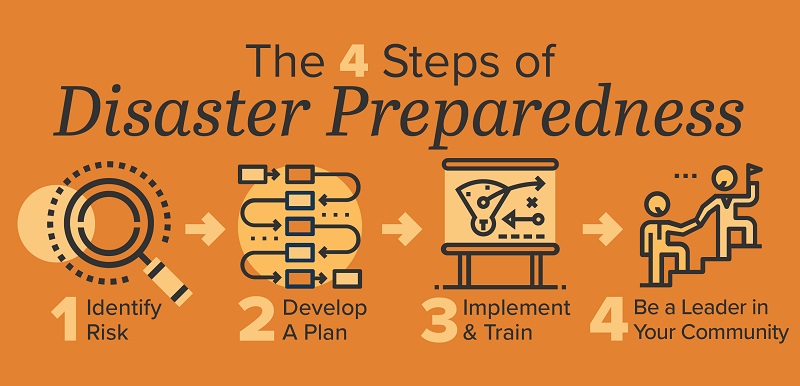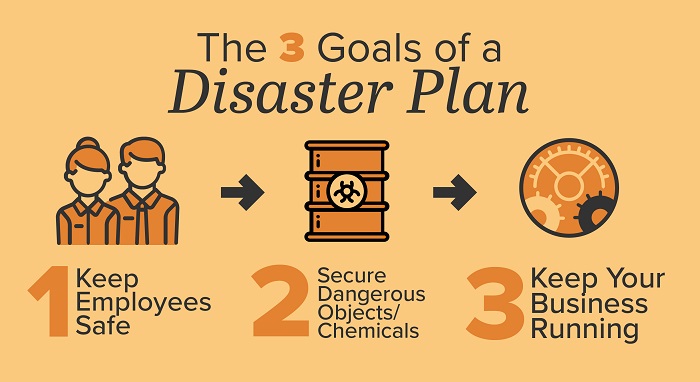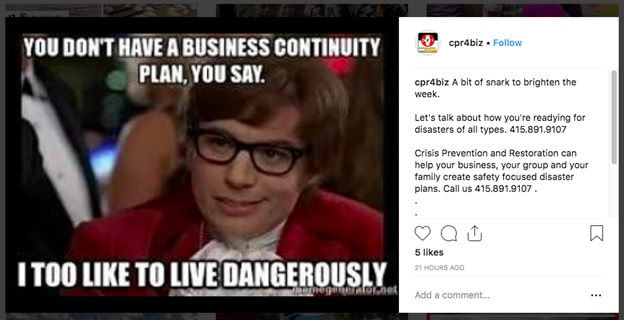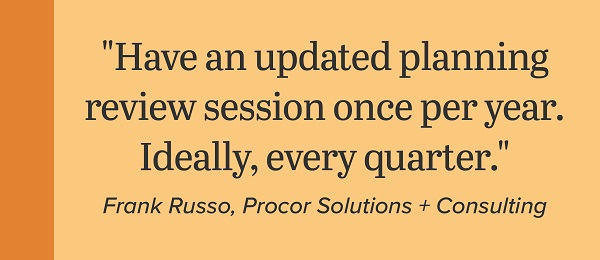Running a small business is hard enough without having to rebuild after a natural disaster. Many businesses all over the world make the mistake of not properly preparing for disasters and are left to suffer the costly consequences. However, small business disaster preparedness planning is easier than you might think. We scoured the internet and interviewed risk management experts to bring you the best tips and resources, so you can finally check "disaster plan" off your to-do list.
What does good disaster preparedness look like?
What does good disaster preparedness mean? We asked Frank Russo, founder of risk management company Procor Solutions + Consulting. He told us an impressive story.
There's a large consumer goods retailer, he said, that calls a standing meeting after every major natural disaster, even ones that had no effect on their business. They talk about what they would have done if the disaster had happened at one of their locations. Russo said that the company builds these brainstorm sessions into a regular "catastrophe gaming process" where employees act out disaster situations. The real-life stress tests identify weak points – for example, a door that can't be locked because the facilities person is on vacation.
In 2008, Hurricane Ike caused a major loss for this company in Houston, but it recovered quickly thanks to all its preparation – so quickly, in fact, that Russo says it actually saw higher-than-normal sales after the hurricane. Why? Because it was one of the only businesses open in the area.
In December 2019, the novel coronavirus (COVID-19) was detected in Wuhan, China, and quickly spread all over the world. As of March 11, 2020, the World Health Organization recognized the spread of the infectious disease as a pandemic. Businesses all over the world have been impacted by the coronavirus pandemic – if you are a small business owner, visit the CDC's website for interim guidance for businesses and employers.
Natural disasters can end small businesses.
Studies show that more than 40% of small businesses close permanently after a disaster. Among the businesses that reopen, another 25% fail within a year.
A good disaster plan means fewer days out of business, better communication with customers, and a better settlement from your insurance company. Add it all up and your plan could be the reason your small business beats the odds.
Look, we know you have a long to-do list. But trustworthy government resources developed over the past few years have made putting together a disaster plan much easier than you'd think. As Russo says, "even a basic plan is better than no plan."
Step 1: Identify risk.
Which of these large-scale disasters is a threat to your business?
- COVID-19
- Hurricanes
- Winter weather
- Earthquakes
- Tornadoes
- Wildfires
- Floods
If you have a single location, you already know the answer. But what about any additional areas that are critical to the success of your business? Think about where computer servers are located, where goods are stored – even areas where your employees commute from or work remotely. This risk assessment table from the Federal Emergency Management Agency (FEMA) will help.
If you have business insurance, make sure you're covered for disasters that could hurt you. Your agent will be able to tell you what coverage you need.
One thing you can do in the next 15 minutes to make your business more prepared is review one of the U.S. Small Business Administration (SBA) and Agility Recovery checklists below.
If you're ready to start your comprehensive plan, the FEMA Ready toolkits at the end of this article are the place to start.
Step 2: Develop a plan.
The key to developing any good plan is to put a single person in charge of it. This is your disaster plan coordinator. They decide how to develop the plan – but you, as the business owner or manager, should be clear about what they need to include. Here are some questions to think about when you assign this important task.
Does the plan coordinator need a supporting committee?
If your business is large enough that it has separate departments, the answer is probably yes. Each internal department will have its own unique assets, systems and requirements. You don't want an outsider guessing what those might be.
Next, think about the entire scope of your operations. Do you ship hundreds of packages a day? Then you want to have someone at your shipping company as part of the supporting committee. Any vendor, supplier or government agency that you use on a day-to-day basis should be represented on your committee. They can explain their own disaster preparedness planning and how that will affect your post-disaster operations.
What are the minimum elements your plan requires?
The goal of a disaster plan is to help ensure the well-being of your employees, the stability of your location's environment and, last but certainly not least, your ability to keep the business running. That may mean you need a 100-page guide, or you may just need a simple series of reference sheets. Either way, your planning coordinator needs to know the scope of your plan before they can properly develop it.
Your plan must address these three goals, at the very least. These are the minimum viable elements of a disaster plan:
- An evacuation policy, including maps and routes
- Whom employees should contact, inside and outside the company, for additional information about what to do
- Who is required to stay onsite to perform essential functions or shut down important items
- Who is responsible for rescue and medical duties
- Employee emergency contact information, plus information about unique medical needs
- Special instructions regarding hazardous materials and equipment, if necessary
What special circumstances does your plan need to address?
Direct your plan coordinator to address any special circumstances related to your employees, your environment or your business operations. Here are some examples:
- An employee with mobility issues
- An irreplaceable piece of equipment that requires maximum protection
- A specific OSHA requirement for storage of a certain chemical
If you have business insurance, this is an excellent time in the prep process to involve your insurance agent. You know that monthly premium you pay? Part of what you're paying for is access to the risk management experts at your insurer. They have seen the aftermath of disasters from coast to coast and can help you decide what to prioritize in your disaster planning.
Here are some other resources to help you build out your plan requirements.
- CDC: Coronavirus (COVID-19)
- WHO: Rolling updates on coronavirus disease (COVID-19)
- Red Cross: Ready Rating
- S. Chamber of Commerce: Small Business Disaster Preparation Quick Guide
- FEMA Ready: Business Impact Analysis
- FEMA Ready: Disaster Plan Performance Objectives
- IRS: Preparing for a Disaster
Step 3: Implement and train.
Your disaster plan coordinator, their supporting committee, and you, as the business owner or manager, should approve the final plan – but your work doesn't stop there.
A disaster plan isn't something you dust off when the red warning stripe comes across your TV screen. You'll have action items as soon as your plan is complete. The idea is to identify things you can do now so you won't have to do them in the days or hours before a natural disaster.
Here are a few examples.
Evacuation routes and wardens
In case of an evacuation, employees need to know where to go. Supply evacuation maps and post them in visible areas. Designate one or more individuals to make sure everyone gets out of the building safely – these folks are called evacuation wardens. The Occupational Safety and Health Administration (OSHA) recommends you designate one warden for every 20 employees.
Disaster communications materials
Approve emergency communications for employees, customers, suppliers and other stakeholders. Write these now, with fill-in-the-blanks to cover disaster scenarios. Make sure people who need access have it both at work and at home. Don't be like the state governor who couldn't tweet because he forgot his password.
Employee go bag
"In the event of a weather emergency, employee safety needs to be the No. 1 priority," said Peter Duncanson, disaster preparedness and recovery expert at ServiceMaster Restore. "Having a preparedness kit on hand, stocked with nonperishable food, clean water, first-aid supplies, and emergency tools like a hand-crank radio and backup batteries will all serve as valuable resources, especially if you have to wait out the storm for an extended period of time."
When you plan the items to include in an employee go bag, consider how far employees travel to your work location and that roads may be rendered impassable. This Red Cross quiz can help you decide what to include.
Training
Every employee in your organization has a role to play during an emergency – even if it's just getting themselves out of the building safely. Your plan should identify which employees are responsible for which roles.
Businesses of all sizes should have a person or team responsible for business continuity and crisis communications. In a small company, this will be you, the owner.
- The business continuity team prepares the business to restart once it's safe to do so. This team also works with the insurance company to recoup losses caused by the disaster. The sooner you start making money again, and the more you get back from your insurance company, the more likely your business is to survive.
- The crisis communications teamis responsible for developing disaster communications and delivering those messages.
Here's a sample training scheme:
Step 4: Be a preparedness leader in your community.
In a natural disaster, you may be at the mercy of your least-prepared neighbor. The unsecured restaurant patio umbrella that comes flying through your window or the hazardous materials that floodwaters carry into your parking lot might not be a threat if you were in charge of them, but you aren't. And the longer your community takes to get back on its feet, the longer you're likely to wait for business to ramp up again.
Communities often come together in the aftermath of a disaster, but it would be even better if they did so before the disaster happened.
Preparedness is good business.
Celebrating your disaster preparedness plan encourages other business owners – and customers – to make their own. It's not only good for the community; it could be good for your business too. Promoting your disaster preparedness efforts helps in these areas:
- Hiring and retention.By showing prospective employees – and reminding current ones – that you take employee safety seriously, you encourage them to join and remain with your company.
- New business acquisition.Talking about disaster preparedness is a way to connect with potential customers and referrers that doesn't require a sales pitch.
- Social media growth.Feel-good stories about your steps to keep the community safe can generate positive social media attention. Don't be shy – you put in the work, and you deserve those likes and shares!
Ready's Business Emergency Preparedness Social Media Toolkit has sample messaging and graphics to work from. They're a little dry, so challenge your marketing team to do better. They should relish the opportunity to talk about something other than your products.
Prepare now so you can improvise later.
Bennett's Market & Deli is a neighborhood grocery in Atlanta's Grant Park. In September 2017, Victoria Bennett and Claire Pearson had owned the store for five years without experiencing a single power outage. But as Hurricane Irma approached, they put their disaster plan into action.
They bought a generator and massive amounts of ice, and collected coolers from folks in the neighborhood. They moved all of their backroom stock off of the floor to protect it from flooding. And they sent staff home, deciding to run the store themselves rather than risk employees' safety.
Then the power went out, and it was time to get creative. With no way to run their credit card processors and cash registers, and no light in the store, Bennett and Pearson were still able to sell beer, wine, bread, and snacks using a cash bag and manual receipts.
"I think the neighborhood really appreciated that we were open," Pearson said.
You never know how bad a disaster is going to be, and you can't control it. Maybe flooding would have forced Pearson and Bennett to evacuate. Maybe the power would've stayed on. But they were prepared, which let them pivot as the situation required. In the end, they formed a stronger bond with their customers.
An expert's take: What you should do right now
Frank Russo, the risk management expert who shared the story about the company in Houston, advises Fortune 100 corporations about disaster planning. We asked him, "What do you tell friends who own small businesses when they ask what they should do?"
"At a minimum, have an inventory of what your assets are, and make sure it's up to date," he said. That's something you could knock off in less than an hour.
Once you've done that, consider following the steps above to create an actionable plan for your business.
"Have an updated planning review session once per year," Russo said. "Ideally, every quarter."
The best action you can take, says Russo, is to weave disaster preparedness into the fabric of your business like the company in Houston did.
The true indicator of your disaster plan's strength will be your business not only surviving the disaster but thriving during the recovery.
COVID-19 information and resources
As ever more information comes out about the coronavirus pandemic, it can be difficult for small business owners to know what to do to prevent the spread of this infectious disease. The Centers for Disease Control and Prevention (CDC) frequently updates its guidance for businesses and employers.
- Actively encourage sick employees to stay home.
- Place posters that outline coughing and sneezing etiquette and proper hand hygiene, and encourage employees to stay home when they're sick.
- Implement flexible working arrangements and supportive sick leave policies. Certain employees may be legally guaranteed sick leave, covered by the Family and Medical Leave Act and/or the Families First Coronavirus Response Act.
- Incorporate social distancing policies and barriers or partitions in your workplace.
- Educate employees on health and safety guidelines, including how to properly use personal protective equipment (commonly known as PPE).
- Instruct employees to wear masks at work (unless they have a condition that prevents them from wearing one) and clean their hands often with an alcohol-based hand sanitizer.
- Conduct daily in-person or virtual health checks (e.g., temperature and symptom screenings).
- Routinely clean all frequently touched surfaces in the workplace.
- Encourage employees to notify their supervisor if they have a sick family member.
- If an employee is confirmed to have COVID-19, inform your team about possible exposure. However, you must keep the employee's identity anonymous, in compliance with privacy protections granted by the American with Disabilities Act (ADA).
- Encourage eligible employees to get the coronavirus vaccine in accordance with the CDC's vaccine rollout recommendations. Individual employee vaccination information must remain confidential, per the ADA.
- Check the CDC's travelers' health notices for the latest guidance and recommendations.
- Conduct a thorough hazard assessment to determine weak points in your health and safety protocol where employees may be exposed to the virus.
SBA and Agility Recovery disaster checklists
The SBA and Agility Recovery provide comprehensive checklists of things you should do in the days before a disaster is likely to strike. Review the ones that are applicable to your business – you want to make sure you can do all of this if necessary. All checklists are printable PDFs, although some may need to be downloaded with a business email.
- Hurricane Preparedness
- Tornado Preparedness
- Wildfire Preparedness
- Flood Preparedness
- Winter Weather Preparedness
- Influenza Preparedness
- Bomb Threat Preparedness
- Earthquake Preparedness
FEMA Ready Business Toolkits
These 40- to 65-page documents are a good place to start. They are generic and broad, because they are meant to work for many different types of businesses. But they do provide a solid framework focused on six factors: staff, surroundings, space, systems, structure and service.
- Hurricane Toolkit [In English/ En Español]
- Inland Flooding Toolkit [In English/ En Español]
- Power Outage Toolkit [In English/ En Español]
- Severe Wind/Tornado Toolkit [In English/ En Español]
- QuakeSmart Toolkit [In English/ En Español]
Skye Schooley and business.com editorial staff contributed to the writing and reporting in this article. Source interviews were conducted for a previous version of this article.





